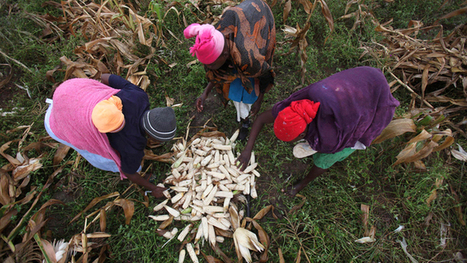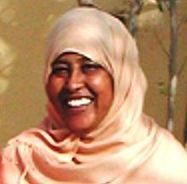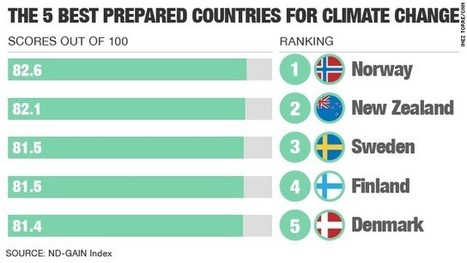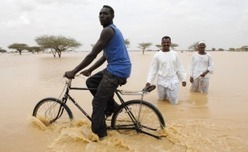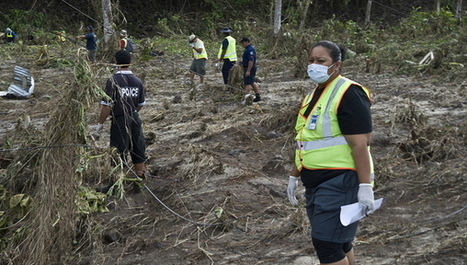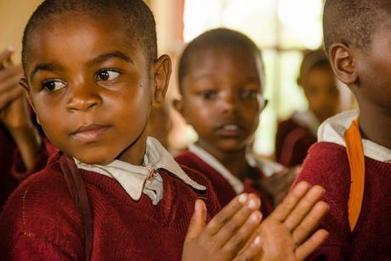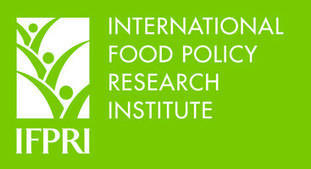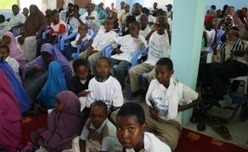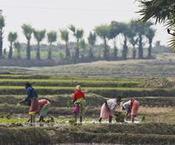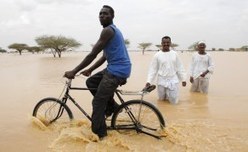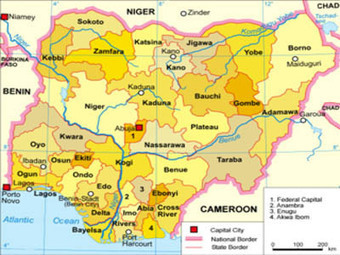 Your new post is loading...
 Your new post is loading...
Displacement, climate change and entrenched abuse block the support women need to enter the agriculture sector, and to be able own land.
A call has been made to the 54 member countries of the African Union (AU) Commission to increase the number of women who own land to 30% by promoting land policies that would address this issue within the next 10 years.
Speakers at last week’s land policy conference hosted at the AU headquarters in Addis Ababa noted that 60% of land in Africa remains uncultivated. With Africa’s population projected to double in 2050, the situation could prove to be dire for millions of families.
...Kenya provides a number of important examples of the power of giving. By July 2011, at least 3.75 million people in the northern part of Kenya were threatened with starvation because of drought. More than 385,000 children below the age of five in 13 districts suffered from acute malnutrition.
In response to this situation, the "Kenyans for Kenya" initiative was launched on July 27, 2011. Spearheaded by leading business and media entities and the Kenya Red Cross Society (KRCS), the aim was to raise Ksh500 million in four weeks for relief efforts. The campaign exceeded all expectations and raised more than Ksh1 billion ($10.5 million); 760,000 Kenyans made a contribution.
The challenge is to replicate and translate the experience of initiatives like this one into ongoing and proactive giving interventions, which not only generate significant resources for good causes, but also nurture public understanding of the issues of concern and contribute to a broad-based giving culture....
Fatima Jibrell, one of Africa’s leading environmental activists was announced Friday as the first Somali to win the UN’s top environmental accolade, the Champion of the Earth award. Stirred by the devastation caused by the civil war in Somalia, Jibrell founded the Horn of Africa Relief and Development Organization in 1991, now known as Adeso – a non-profit organization operating in South Sudan, Somalia and Northern Kenya – to bring environmental and social justice to war-torn regions and communities.
Analysts are right to assess the level of national preparedness to climate change -- but well-intentioned efforts to rank countries can inadvertently sow hopelessness among those considered to be ill-prepared.
A recent University of Notre Dame Global Adaptation Index (ND-GAI) ranks Norway, New Zealand, Sweden, Finland and Denmark as the world's best prepared nations. At the bottom of the adaptation index lie Democratic Republic of Congo (DRC), Central African Republic, Eritrea, Burundi and lastly Chad.
By leveraging knowledge about climate change, through adopting improved agriculture technologies and using water and energy more effectively, Africa can accelerate its march towards sustainable development.
Policy and development practitioners say Africa is at a development crossroads and argue that the continent -- increasingly an attractive destination for economic and agriculture investment -- should use the window of opportunity presented by a low carbon economy to implement new knowledge and information to transform the challenges posed by climate change into opportunities for social development.
The world is getting warmer and that’s already causing disasters that will devastate lives and cost hundreds of billions of dollars.
Those problems are only getting worse, as shown by recent reports from the United Nation’s Intergovernmental Panel On Climate Change (IPCC) and the White House, among others.
The greenhouse gas emissions that drive warming “now substantially exceed the highest concentrations recorded in ice cores during the past 800,000 years,” the IPCC said. Atmospheric carbon dioxide levels, which primarily come from the burning of fossil fuels, have risen 40% since preindustrial times.
Last month, world leaders convened at the UN Climate Summit 2014 to discuss plans to reduce carbon emissions — though there were some notable absences. Most attendees recognised that failure to address these issues could spell terrible consequences for people all over the world. We’ve gathered some of those terrible consequences of climate change below.
Unless otherwise noted, each effect assumes a temperature rise of 2 degrees Celsius (3.6 F) by 2100, a number the IPCC has suggested we are “more likely than not” to exceed, and a sea level rise of 0.5 meters (1.5 feet) by 2100, about the average of all the IPCC’s most recent climate scenarios. This is a conservative estimate — other studies predict significantly more sea level rise.
The United Nations Climate Summit, held in New York this week, has seen the unveiling of a coalition convened to examine how to embed climate and disaster risk stress testing within banking and securities regulation, investment and accounting practices.
This is the ‘encoding’ of disaster risk and resilience within the financial markets that has been a mantra of insurance and reinsurance broker Willis Group, a key participant in the UN-led initiatives facilitating the development of a post-2015 framework for disaster risk reduction. The activities which seek to embed disaster risk and resilience within the financial markets of the world, including the disclosure of disaster exposures and accounting for both the negative, caused by exposure to disaster risk, as well as the positive, of response and resilience, are all part of the work which comes under the banner of the Hyogo Framework....
This blog post by Secretary of State John Kerry, Secretary of Agriculture Tom Vilsack and USAID Administrator Rajiv Shah was originally published on the State Department website on September 24.
...By 2050, the world's population is expected to reach 9 billion people. Feeding them will require at least a 60 percent increase in agricultural production. There is no greater challenge to meeting this need than climate change. It poses a range of unprecedented threats to the livelihoods of the world's most vulnerable people and to the very planet that sustains us. In order to ensure that hundreds of millions of people are not born into a debilitating cycle of under-nutrition and hunger, we must address the urgent threat that climate change poses.
That's why today we're announcing the launch of the Global Alliance for Climate-Smart Agriculture. The idea was born eight months ago, when an international delegation of leaders -- including many from the USDA, the State Department, and USAID -- met in South Africa for the Global Conference on Climate Change, Food Security, and Agriculture. There, we charted a more sustainable path to food security -- one that preserves the environment while driving broad-based economic growth....
The UN’s ‘pre-zero draft’ of the post-2015 framework for disaster-risk reduction calls for a marriage of science and community-level expertise. The final framework will set out what various sectors can do to reduce risks from catastrophes after the current framework expires in 2015. According to the draft, scientific and technical capacity will be useful for managing disaster data and assessing peoples’ vulnerability to hazards related to climate, geology and water, while the leadership, capacities and resources of local communities are considered essential for disaster risk reduction. [1]What is missing from the draft is recognition of the significant differences in how male and female victims experience disasters.
Faced with increasingly scorching heat and drought that have lasted two years in Kitui County in Eastern Kenya, a community banking group has moved their investments to a new climate-resilient currency: goats.
The small-scale farmers, who contribute funds to a savings pool and are eligible for small loans from it, aimed to use the funds to improve their farms and boost their harvests of hardy crops like pigeon pea
Impoverished states have had to divert large chunks of their budget to adapt to climate change and run the risk of crowding out spending on health and education, a new report suggests.
Between 2008 and 2011, Ethiopia committed 14% of its national budget to climate change, or nearly half of the national spending on primary education. Meanwhile, Tanzania spent 5%, which is almost two-thirds of its health spending, according to the report by the Overseas Development Institute (ODI).
Ethiopia, Tanzania and Uganda, the three countries featured in the report, are heavily dependent on rain-fed agriculture, and have all experienced higher temperatures and reductions of water sources consistent with climate change. All have invested heavily to adapt their farming and cities in the absence of promised international aid, said Neil Bird, a climate researcher at ODI who wrote the report.
BLOG by Paul Venton,Specialist in disaster risk reduction
Every year storms, floods, droughts and other extreme events affect hundreds of millions of people around the world, with economic losses estimated at $100 billion. These all-too familiar scenes of loss and destruction are referred to as 'natural disasters'; however, I've come to recognize that this is a stunning misnomer. The phrase implies that nature causes the disaster, when humans are often the main culprits. In fact, rather than being thought of as the cause of disasters, nature should be better appreciated as a critical part of the remedy to them.
Natural Defence Against Un-Natural Disaster Huffington Post I believe these efforts to embed ecosystem-based disaster-risk reduction and climate-change adaptation in economic-development decision making must be supported by business leaders and the...
This post is part of a month-long series produced by The Huffington Post in conjunction with a variety of events being held in September recognizing the threats posed by climate change. Those events include the UN's Climate Summit 2014 (to be held Sept. 23, 2014, at UN headquarters in New York) and Climate Week NYC (Sept. 22-28, 2014, throughout New York City). To see all the posts in the series, read here.
Moderated by: Dan Glickman Panelists: Shenggen Fan, IFPRI Rachel Kyte, The World Bank John McDermott, CGIAR Research Program on Agriculture for Nutrition and Health, IFPRI Cynthia Rosenzweig, Goddard Institute for Space Studies at Columbia University
Organized by IFPRI and the Chicago Council on Global Affairs
As the food system grows more fragile, climate change and increasingly volatile weather are reducing agricultural productivity globally. There is an urgent need for strategies to build resilience for the world’s farmers to adapt to these changing conditions. Building on the resilience themes presented in two recent conferences, the IFPRI 2020 Conference on Building Resilience for Food and Nutrition Security and the Chicago Council Symposium on Advancing Global Food Security in the Face of Weather Volatility and Climate Change, this panel will examine the key issues that must be on the international agenda over the next year. In anticipation of the upcoming UN Climate Summit and preparation of the Sustainable Development Goals, panelists will highlight important issues that need to be brought to poliymakers’ attention.
Watch live: http://www.ifpri.org/event/building-resilience-face-climate-change-and-weather-shocks.
|
Agriculture is the main economic activity for the more than 80 percent of the population in Kenya, with rural households drawing direct livelihoods from it.
Unfortunately, the small-scale farmers continue to solely depend on rain to carry out their farming activities, a reliability which has resulted to crop failures, thereby endangering household food security.
New study documents surge in “climate services” in Africa and South Asia that allow farmers to see their fields in the future tense and adapt to changes.
A massive new University of Colorado Boulder study indicates there is a statistical link between hotter temperatures generated by climate change and the risk of armed conflicts in sub-Saharan Africa.
CU-Boulder Professor John O'Loughlin led a research team that assessed more than 78,000 armed conflicts between 1980 and 2012 in the Sahel region of Africa - a semi-arid belt just south of the Saharan Desert that spans about 3,000 miles and more than a dozen countries from the Atlantic to the Indian oceans.
The team was looking for links between armed conflicts and temperature and rainfall anomalies, as well as assessing other causes of violence in the Sahel. "We found a clear signal that higher temperatures in the Sahel over time does increase the risk of conflict," O'Loughlin said.
Climate change and food insecurity are amplifying the risks of conflict and civil unrest in 32 countries, including the emerging markets of Bangladesh, ETHIOPIA, India, Nigeria and the Philippines, according to the seventh annual Climate Change and Environmental Risk Atlas (CCERA) released by global risk analytics company Maplecroft.
The Atlas, which provides comparable risk data for 198 countries across 26 separate issues, identifies Bangladesh as the country most at risk, followed by Sierra Leone, South Sudan, Nigeria, Chad, Haiti, Ethiopia, Philippines, Central African Republic and Eritrea.
The devastating effects of climate change are already being felt across the planet, including in Africa. The 2011 drought-induced famine in the Horn of Africa affected more than 10 million people, claimed 257,000 lives and cost over $1 billion in damages. The recent Africa Adaptation Gap report by the UN Environment Programme warns that climate change could reduce total crop yields in sub-Saharan Africa by as much as 20% by 2070. Worse still, it could begin to affect Africa’s trade potential. For example, a projected sea-level rise in Tanzania of 70 centimeters by 2070 could devastate the port city of Dar es Salaam, its largest and richest city and a major player in East Africa trade, and cost the country about $10 billion in property damages and related losses. Environmentalists warn that rising sea levels can cause severe flooding, submerge land and destroy coastal ecosystems...
Among the topics being discussed at the 2014 World Climate Week in New York City (22-26 September), are financing resilient cities, corporate actions for resilience, the ways data can support resilience moves, and women's leadership in resilience planning.
IRIN looks at some of the successes, failures and pitfalls in resilience planning.
An initiative to enhance the capacity of the Tanzania Government to develop and implement policies on climate change adaptation in relation to food security in the country was launched at the end of last week, in Dar es Salaam.
The four-year project, Policy Action for Climate Change Adaptation (PACCA), is led by the International Institute of Tropical Agriculture (IITA) and funded by the CGIAR Research Program on Climate Change, Agriculture and Food Security (CCAFS). It is being implemented in both Uganda and Tanzania. In Tanzania the project will be implemented in partnership with the Environmental Management Unit (EMU) of the Ministry of Agriculture, Food Security and Cooperatives.
Scientists have combined genetic analyses with new modelling approaches to help identify how well balsam trees are adapted to handle climate change.
The 2016 World Humanitarian Summit in Istanbul is an opportunity to rethink the way we plan for and respond to humanitarian crises. We need to acknowledge that not many humanitarian crises have purely humanitarian solutions. To meet the humanitarian challenges in the decades to come, we must put disaster and conflict-affected people in the driver’s seat.
“Diplomat News Network Drought-Hit Horn of Africa UN, IGAD Appeal for Humanitarian Aid AllAfrica.com The UN and East Africa's regional community on Monday, appealed to the international community to move swiftly and avert a looming humanitarian...”
Kenya lacks adequate weather recording stations, according to the 2014 African Agriculture Status report.
Dr. James Kinyangi, a lead author of the report, says there is extremely low coverage by existing weather stations, leading to limited provision of accurate data.
"There is also poor use of historic data that could help inform decision making. Many countries in Africa have national metrological departments, but the agro-meteorological division constitutes the minor part of any MET services," says Kinyangi, noting that there is also a disconnect in communicating relevant information to farmers.
Kinyangi added that for climate data, you need long-term data,and few weather stations are actively tracking and reporting this information...
|



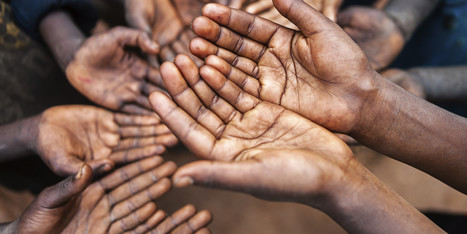


 Your new post is loading...
Your new post is loading...
